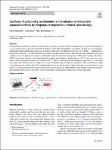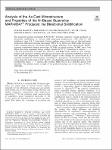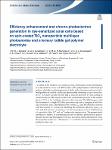Search
Author
- Bandara, T. M. W. J. (1)
- Cygan, Rafał (1)
- Felix, Leibetseder (1)
- Francesca, Luziatelli (1)
- next >
Subject
- XRD (2)
- crude cellulase cocktail (1)
- glass-transition tempe... (1)
- SEM (1)
- next >
Date issued
- 2023 (5)
Has File(s)
- true (5)
Search Results
Differential scanning calorimetry (DSC) was used as an efficient and rapid tool in studying the conformational transitions between the folded and unfolded structures of cellulolytic enzymes. The thermal properties of two crude hydrolytic enzyme cocktails containing extracellular cellulases from Trichoderma longibrachiatum DIBAF-10 were analyzed and compared with three commercial cellulase preparations. Differences in the thermal behavior of fungal cellulases in the liquid phase, freeze-dried state, liquid formulations in sodium citrate buffer (pH 4.8), and contact with cellulose, carboxymethyl cellulose, and cellobiose were evaluated. DSC profiles of cellulases from the DIBAF-10 strain provided important thermodynamic information about the thermal stability of the included proteins.... |
Common linear polymers are known to undergo phase changes at the glass-transition temperature (Tg) and the melting point (Tm). In recent years, it has also been shown that molecules with long aliphatic side chains can give rise to a backbone-independent melting phenomenon, known as nanophase separation. This effect describes the self-assembly — independent of the polymer backbone — of alkyl side chains into semi-crystalline nanostructures. This work presents optimized, gram scale synthesis routes for dodecyl and octadecyl acrylamide and their respective homopolymers. Differential scanning calorimetry (DSC) experiments detected a broad endothermal signal for poly(n-dodecyl acrylamide) at − 29 °C and a narrower, more intense signal for poly(n-octadecyl acrylamide) at 34 °C. These sign... |
The presented research investigates MAR-M247® Ni-based superalloy castings produced via directional solidification at various mold preheating temperatures (1510, 1566 °C) and withdrawal rates (3.4, 5.0 mm/min). Casting analyses were carried out via thermodynamic simulations, differential scanning calorimetry (DSC), X-ray diffraction (XRD), light microscopy (LM), scanning electron microscopy (SEM), energy dispersive X-ray spectroscopy (EDX), scanning transmission electron microscopy (STEM), and tensile testing. On DSC curve, four effects have been registered during cooling: liquidus (1337 °C), formation of eutectic γ − γ′ (1315 °C), precipitation of Ni7(Hf, Zr)2 (1244 °C), and M5B3 borides (1201 °C). The castings’ primary and secondary dendrite arm spacing decreases with increasing w... |
SnxSb20Se80−x bulk glasses were prepared using the well-known melt quenching technique, where x was taken as 7.5 at.%, 9.5 at.%, 11.5 at.% and 13 at.%. X-ray diffraction (XRD) and differential scanning calorimetery (DSC) were used to monitor the crystallinity and transition temperatures, respectively. XRD examinations showed that the 7.5 at.% and 9.5 at.% compositions were purely amorphous, while the other two compositions exhibited a crystalline structure. DSC thermograms demonstrated that 7.5 at.% and 9.5 at.% alloys had a single crystallization peak, whereas for the 11.5 at.% and 13 at.% alloys, two exothermic peaks and three peaks appeared. |
he effect of the thickness of a multilayer TiO2 photoanode on the performance of a dye-sensitized solar cell (DSC) made with a polyethylene oxide-based gel polymer electrolyte containing ternary iodides and performance enhancer 4-tert-butylpyridine is studied. Multilayer photoanodes consisting of up to seven layers of TiO2 nano-particles (13 nm and 21 nm) are prepared by spin coating of successive layers. XRD results confirm the predominant presence of the anatase phase of TiO2 in the multilayer structure after sintering. The SEM images reveal the formation of a single TiO2 film upon sintering due to merging of individually deposited layers. The photocurrent density (JSC) and the efficiency increase with the number of TiO2 layers exhibiting the maximum efficiency and JSC of 5.5% and... |





